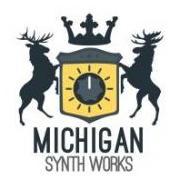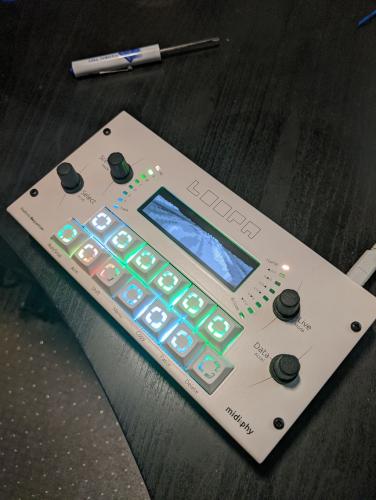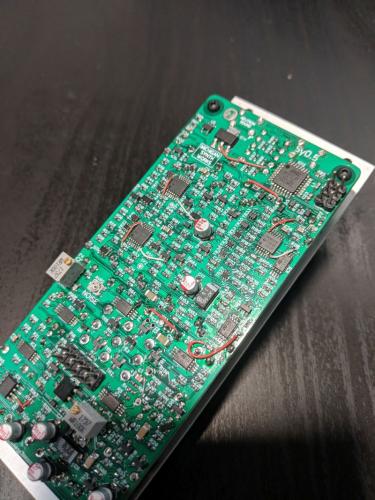-
Posts
1,184 -
Joined
-
Last visited
-
Days Won
30
Content Type
Profiles
Forums
Blogs
Gallery
Posts posted by Altitude
-
-
nice. Need to start paying more attention here, lots of great projects slipping under the radar
-
 1
1
-
-
any 10 pin female header that style will work, the height on that one wont matter
-
no compensation needed. I know how these things go.
I wish I could have found the actual spot where it was shorting, it definitely wasn't a board problem since I did inspect the underside pins after I cleaned it off and it worked with the new header so that only leaves the solder bridge and that fits the symptoms. Checking for shorts to adjacent I/O pins would have identified the issue, might be worthwhile to spot check a couple in inventory to make sure it was just a fluke and not a batch thing.
anyway, that's that.
-
Solved!
And this is some crazy ass shit too: I was friction fitting the core with the mainboard to see if removing the TVS fixed it (it didnt) so the plan was to try the temporary headers like andy suggested with the minimal setup but my trimmed down, solder coated ones were not fitting the sockets i had so I decided just to put new headers on the core, not a big deal, suck out the solder and pull the pins out one at a time. When I did the first row and pulled off the plastic header there was a fair amount of solder where the plastic was (like it puddled there). I just ignored it thinking it was from the desolder gun and cleaned it all up but after the clean up, and new headers, it fired right up. In hindsight, there was way more solder there than should have been, I was sucking out solder through one end and pulling the pin out through the other, what was left there after I removed the plastic was in the shape of the plastic header like a mold, there is no way that came from the desolder gun especially since it sucks solder out or from any other soldering I did since those were on the other side of the header. I checked all the IO pins for shorts to ground and +5 but NOT to each other which seems to be what was happening here, must have happened in the wave machine when those headers were soldered on at the factory. Just dumb luck i decided to replace those, I would have never found it otherwise, should have taken a picture
-
 1
1
-
-
Just now, Antichambre said:
Maybe stupid but... A faulty usb cable? The one you use with LoopA is necessarily different from the one you use directly with the waveshare, so...
On sait jamais ;)tried 3 different ones
-
good idea. I want to triple check everything before I put the core back on. I use the same diode in a couple device i sell but the list of possible suspects is getting short.
-
was the alt-page thing ever fixed? so you could scroll up and down in note view?
-
I cant find anything wrong with the connections on the mainboard, no shorts, no weird resistance. Here's pics of the core. Yes I am aware its set to USB (i was testing it without the mainboard)
-
44 minutes ago, Hawkeye said:
..Before you desoldered the Waveshare daughterboard, i would have guessed the STM32F4 might have been a dud, maybe bad flash memory... But if it starts up and boots the app when powered by mini USB, that's clearly working. And as you said, it must be some connection to the USB port...
Question that was probably asked before: did you have the onboard Waveshare power switch moved from "USB" to "5V In", when it was installed in the LoopA core? That's the only thing that could explain it, i think - if that switch was not moved to 5V, the Waveshare board wouldn't get proper power and would not start up when powered by external LoopA Core USB. Two red small power LEDs should be lit on the Waveshare board when all is well. You made sure of that probably, but to be sure just wanted to mention it anyways :).
If it's a hardware defect on the LoopA core or the Waveshare, we're glad to send you replacements of course, but it would be great to trace it and find the problem - thanks again for the tests and your patience!
@latigid on: could we try to trace the USB signal pins from the STM32F4 microprocessor right to the USB port on the LoopA core? Which connections would need to be tested?
Best regards,
Peter>..Before you desoldered the Waveshare daughterboard, i would have guessed the STM32F4 might have been a dud, maybe bad flash memory... But if it starts up and boots the app when powered by mini USB, that's clearly working. And as you said, it must be some connection to the USB port...
I thought that too so I swapped the STM chips and it behaved the same way so it wasnt the chip. That was further proven when I took the core off and that worked by iteself. Its something on the mainboard thats hanging it up..
>did you have the onboard Waveshare power switch moved from "USB" to "5V In", when it was installed in the LoopA core?
yes.
now that the core is off I'll trace back to the USB socket when I get some time. Either its something stupid that I missed (likely) or some weird edge case issue (unlikely)
-
> Was the v407 breakout actually soldered in? If so, impressive that you managed to get it out so well!
Yeah, it wasnt fun. Hot air FTW
-
ok, some more developments.
> Could you try to use another computer and another USB cable for uploading?
tried it, no change in behavior.
> could you try to enter bootloader hold mode and try to reflash from there? Just got this tip from Robert. You'd need to populate JPA0 and R101 and R102 on the core board and jumper JPA0 - then you should see the bootloader in MIOS studio and could hopefully try to upload again.
Just to clarify, I have always been able to see the bootloader ports and upload code. It will occasionally (like 1 out 20 times) start the app with the miniusb directly connected to the core otherwise only the main usb goes as far as the bootloader ports showing and accepting an upload but beyond that its not working right, I cant send commands through MIOS studio. It just does nothing when I enter commands
other things i tried:
wipe the core, reflash the bootloader with the STlink (no change in behavior)
Change the STMF407 (no change)
I finally pulled the core off and that tried that by itself and it fired right up with the mini USB (Loopa midi ports available), and normal MIOS Studio terminal behavior so it looks like the issue is somewhere on the main board that's halting the core. Ive gone over it several times and dont see where the issue is, need a fresh set of eyes.
-
Im not sure where to go from here.
1. Power good. 5V and 3.3V where marked
2. rehit all joints on the header, no change
3. Orientation of TVS is correct
4. 22R resistors are fine
5. Tried various USB cables/multiple computersOther observations:
- the app started once. This was with the mini USB direct to the core, i could not repeat this behavior
- I can no longer get the miniUSB to do anything, it will start the device since the power led will fade in and out but no USB devices show up
- nothing is coming out of the midi ports
- with the main USB connected, I get the upload request over USB and feed back when I send the hex but I cannot send any other console commands to the bootloader (i.e."help" does nothing)
Does your core = the STM discovery core? As in does it take the same bootloader?
-
Tried all those already including reflashing the bootloader.
I'll go over the core header again
-
10 hours ago, Hawkeye said:
Another idea - are you by chance using a Mac? With their newest O.S. i think the USB ports are not renamed after flashing a firmware via MIOS Studio - that would mean you'd already have the LoopA software on, but the USB port is still listed as MIOS bootloader - if that's the case, there is a way to reset the USB cache, quoting TK.:
"So far we only noticed a minor issue when an app changes the number of USB MIDI ports or the device name. Such changes won't be taken over automatically, instead you've to delete the old interface description in the Audio-MIDI-Setup:
- start the Audio-MIDI-Setup of MacOS (e.g. search for "audio-midi" with Spotlight)
- disconnect the core module from USB
- delete the interface in the Audio-MIDI-Setup
- connect the core module to USB again"
If that also was not the cause, i think there should be the option to directly connect a mini-USB Cable to the waveshare daughterboard on top of the LoopA core - then i think the Waveshare Core power selection switch needs to be set to USB - this should then allow MIOS Studio to upload the hex directly. If that worked, there might be a connectivity problem between Waveshare core and the LoopA core USB port.
If uploading via the mini USB port also fails, we'd kindly ask for pictures of the front and backside of the core PCB to have a closer look :)
Best regards!
Peter> could you check if you're using the newest MIOS Studio 2.4.9?
Check.
>Another idea - are you by chance using a Mac
no
>connect a mini-USB Cable to the waveshare daughterboard
Ok, here's where it gets weird. That DOES work. The app will boot and I will get the Loopa ports now. So that means that the main USB seems to be working but there is something hanging up the core preventing it from starting correctly.
-
yeah, its right. This is weird, its like there is something up with the hex file.
-
when I'm programming the core, I cant seem to get the program to stick, I see the ports in the MIOS studio, I can query the core, get the upload request and I can send the project hex but after its done and I power cycle it, i'm right back to the bootloader like there is no app, thoughts?
PS: Peter, you should look into a side hustle doing ASMR stuff
-
 1
1
-
-
12v is fine.
-
Nice. That's exactly what I had in mind. PM'd
-
very cool. PM me an SVG of the cutout for the display and I'll layout a snap in window
Are there options for the switch caps? (i.e. a source)
-
-
Just now, Antichambre said:
Even with all the red stripes this is beautiful, there's a lot of work in this, what it is?
My new euro module: https://michigansynthworks.com/p/sy0-5-analog-drum-module-coming-fall-2018
-
-
Im with Andy, I always make the isolation as BIG as practical. If you have to pack it in, you have to pack it in but only do so where absolutely needed. You can pour different polygons with different isolation on the same net too if you need it tight one place and not another. Every time i've gotten bad boards from OSHpark (3 times this has happened) it was because there was a super tight/dense space and the etching didnt get all the copper. They are probably way more sensitive to this than other fabs since they do big ass boards with many designs and i bet its easy to have issues etching something that size.
I think it boils down to getting a handle of what the fab says they can do and what they can actually do reliably. I had problems with Seeed with my first order there and never went back, the etching was rough, the soldermask was poorly registered, just blah everywhere. JLC i'll use for big stuff since their pricing is good but small stuff they have issues with clean screens even at their minimum text size spec. PCBway has nice machines but they take a maximum X size of 110ish mm so big stuff gets pricey there too, They cant do small text like OSHpark can on that machine. So it's a mixed bag always where ever you go. I go through a thousand boards a year and have yet to see a etching fault on any of the Chinese fabs which is why I dont use OSHpark anymore, it was a convenient service 5 years ago but the prototype biz in china has exploded and you can do much better for much less time and money. Standard turn around for protos is 2 days at any place out there
-
works for me :)





FS: MB-808 Assembled with case, power. Rev 2 PCB
in Fleamarket
Posted · Edited by Altitude
So I've decided to let this go. Its a rev 2 PCB so there are a lot of bugs all of which have been fixed EXCEPT the cymbal. It works, but its not right. I have the eagle stuff and schematics but I just dont have time to work on this anymore so its sold AS IS.
(not all the jacks are installed, they will be when I ship)
its 115V AC powered
Includes an extra overlay, i had 2 made just in case
$450 (less than half what I've spent on it) CONUS preferred.